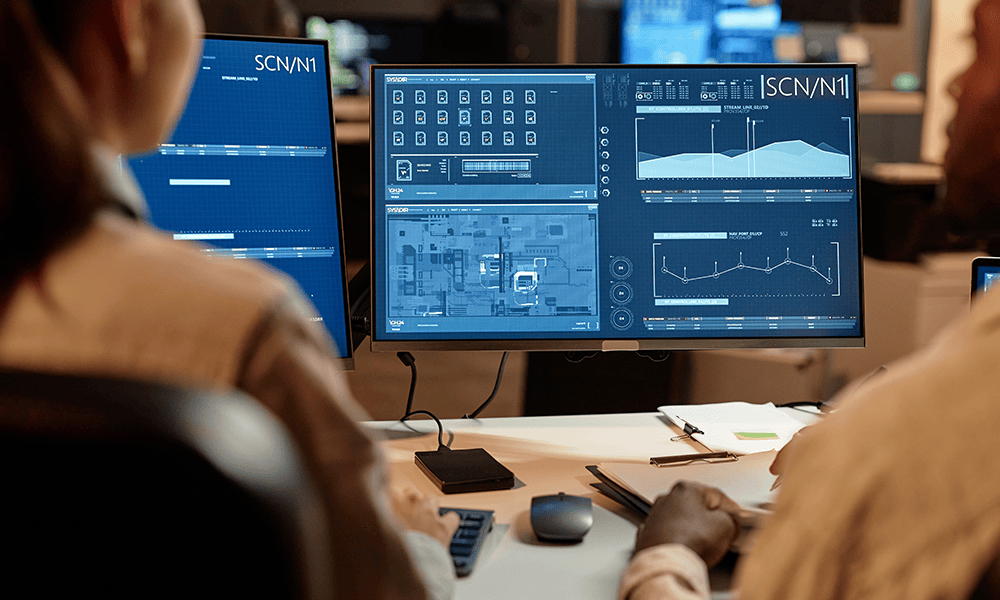Data breaches and network slowdowns can disrupt business operations, making IT network monitoring essential. An optimised network keeps data secure, reduces downtime, and ensures smooth business functions. This guide covers seven key best practices to keep your network in top shape.
This blog covers essential IT network monitoring best practices like real-time tracking, user activity monitoring, and performance thresholds, offering actionable strategies to build a resilient, secure, and efficient network for your business.
Network monitoring involves continuously observing, mapping, and analysing an organisation’s computer network. By tracking network activity, identifying potential bottlenecks, and detecting security threats, network monitoring helps prevent disruptions, data breaches, and costly downtime. Simple network management protocol including this proactive approach ensures that systems remain reliable, responsive, and secure, allowing IT teams to swiftly address any issues before they impact business operations.
Network monitoring is more than just “keeping an eye” on systems as its about proactively managing and securing your network and keeping an eye on your networks behaviour. Data from studies show that organisations with consistent network monitoring report 45% fewer incidents, underscoring its importance in maintaining uptime and security. But what does effective monitoring entail? Let’s explore the core practices.
Here are the top practices you should follow to ensure you have an effective network that remains secure, efficient, and capable of supporting your business’s needs.
Real time network monitoring provides instant visibility, allowing IT teams to address issues before they affect operations. Using these tools enables continuous tracking of network traffic, device performance, and server health. For many businesses, effective network monitoring can be the difference between spotting a minor irregularity and reacting to a full-blown crisis.
Establishing clear policies is essential. Outline specific goals for network monitoring, such as reducing downtime, detecting security threats, or managing bandwidth. These policies should also define critical elements like access permissions, alert thresholds, and incident response protocols. A well defined policy helps streamline monitoring activities and ensures everyone in the team knows their responsibilities.
Automation has become indispensable for network monitoring solutions. Setting up automated alerts for unusual network activity means IT professionals don’t have to monitor dashboards 24/7. With automation, responses are faster, and common issues can be resolved without manual intervention. Automated responses can include sending alerts, restarting services, or even blocking suspicious IP addresses.
Regular network audits allow you to review system health, configuration, and security status. By conducting audits, you can catch outdated equipment, unpatched software, and other vulnerabilities. These audits should cover everything from bandwidth usage to user activity logs. Many successful organizations schedule audits quarterly to catch potential issues before they become problems.
Benefits of Regular Audits:
Tracking user activity is essential for both performance and security. With cyber threats on the rise, it’s crucial to know who accesses your network and what they do once inside. Implementing user activity or security monitoring helps identify and locate unauthorised access, detect unusual behaviours, and ensure compliance with data protection policies. By seeing the devices on a network too is also a way of monitoring teams who work in your company to see who has network access.
Setting thresholds for network performance, like CPU usage, memory load, and network traffic, can greatly enhance monitoring effectiveness. For instance, if CPU usage consistently exceeds 80%, this could indicate a performance bottleneck. Alerts triggered by these thresholds help IT teams react before minor issues turn into major disruptions and will ultimately improve network performance/
Example Thresholds to Monitor:
Network monitoring tools are a significant investment, and choosing the right tool is key to maintaining network health. Look for software that can scale with your organisation’s needs, offering flexibility in managing multiple network elements.
Top Features to Look For:

Consistent network monitoring is crucial for ensuring reliable service. Here are some of the primary benefits:
Advanced network monitoring detects potential issues before they escalate, helping prevent expensive data breaches and minimizing costly downtime. It also identifies underutilised or overburdened network resources, enabling cost saving adjustments.
Network monitoring plays a vital role in security by spotting unusual traffic, unknown devices, or rogue applications. It provides visibility across all network components, helping prevent unauthorized access and identifying potential insider threats.
Alerts can trigger automated actions, like spinning up a new server if CPU usage exceeds a threshold. This pre-emptive approach keeps networks running smoothly and prevents resource strain.
Monitoring warns admins of potential incidents, giving them time to initiate disaster recovery plans (DRPs). This process helps prevent major disruptions and ensures business continuity.
By addressing performance issues quickly, network monitoring helps maintain operational efficiency and supports employee productivity. It also frees up IT teams to focus on improvements rather than resolving constant issues.
Monitoring tools offer valuable data for decision-making, highlighting trends that can guide future infrastructure scaling. Historical data helps anticipate growth requirements and pinpoint network gaps that need attention.
Network monitoring is an essential IT process for identifying, mapping, and overseeing computer networks and their components, such as routers, switches, servers, and firewalls. This process enables network administrators to assess performance and enhance network efficiency in real time.
The main goals of network monitoring are to ensure network uptime, optimize performance, identify security threats, and reduce operational costs by quickly detecting and addressing issues.
Ideally, network monitoring should be continuous, with real-time alerts for critical events. This approach allows for immediate detection and response to issues.
